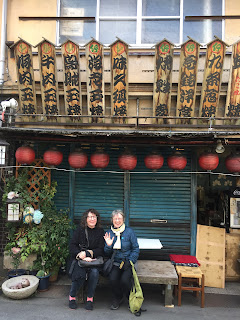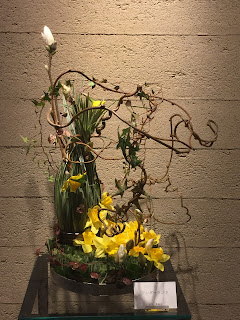In Japan we are constantly bumping into the question: What does "old" mean when you are talking about culture, buildings and historic places?
To illustrate the conversation/dilemma, lets start with our trip last weekend to Kyoto. Travel by Shinkansen always starts at Tokyo Station, the heart of Tokyo, built right next to the Imperial Palace in 1914.
It stands today looking exactly as it did in 1914, right down to every detail of the turrets and the copper decorations....
But when you do a little research (click here for a fascinating video) it turns out that the building was badly damaged during the Great Kanto Earthquake, had the second roof and towers burned off by the Allied fire-bombing, and was "modernized" before being "historified" for the new grand opening in 2013. Is this an old building???
Zipped down to Kyoto via the bullet train, this being our third visit we have gotten to know our way around some of the interesting old neighborhoods that are tucked in behind the huge modern buildings and the big tourist sites. We enjoyed with our friend visiting from New Zealand browsing through some of the old stores and seeing how life has been lived for many years in "old" Kyoto.
These were truly old neighborhoods not destroyed by bombings or earthquakes.
Kyoto is known for its stunning old temples in every sense of what I consider old. This wall was originally built in 1450.
This temple, Rengeo-in, was built in 1266 ...
to house a stunning display of 1000 armed Kannon statues (see here for more).
This was an "old" temple with "old" statues!!
This temple was founded in 888, destroyed in 1467, rebuilt 150 years later, with dry gardens raked every day since 1500s as the monk's meditation; every day!... yes; this was old. (See here for the history of Ninna-ji)
There are the old temples re-done with new renovations.... done with the old techniques... with young craft people... who come from old temple repair families...using old techniques. Check out this family business repairing and re-building temples for the last 1400 years!!! (Click here)

Within the renovations the paintings on the fusuma doors are "old" and not redone.
While here, at Renge-ji temple the guardians at the gate are nestled in re-built gates they have their original peeling paint cover.
We had the chance to re-visit one of the most visited temples in Kyoto, the Golden Temple (and yes, it was very cold and beginning to have some snow blusters.) This stunning temple was originally built in 1397, then destroyed during the Onin war in the 1400s, then re-built only to be burnt down by a deranged monk in 1955. The temple and all of the treasures were lost (click here for more) ... only to be re-built exactly as is was in the 1600s, with all of the statuary reproduced exactly as it was. The craft people were from one of the families that have been building temples for over a 1000 years.
This is a beautiful (and crowded) temple. Is it "old" or is it "new"?
Behind this highly touristic and beautifully redone temple, there is a less well-known temple walk that has 88 mini-temples tucked in the woods as a mini-pilgrimage equivalent of the Shikoku pilgrimage. Most of these mini-temples and shrines were evidently built within the last 100 years, and they are slowly decaying back into the underbrush. Some of the shrines have been topled by earthquakes. Vines and shrubs are slowly covering the path and the buildings.
Are these sites "old" or "new"?
We found this exhibition quite exhilarating because it was a complete modern take-off on the art of Ikebana. Using some of the old techniques they created a new vision of flower arranging; quite fascinating.
Is this "old" or "new" Ikebana?
And then of course there is the amazing 80 year artist Yayoi Kusama, who lives in a mental institution and has some of the other patients help with her work. Her work is vibrant, flamboyant and eye-catching. It is definitely "new" as this piece is front of the Kyoto Art Museum.
What do you think?




























No comments:
Post a Comment